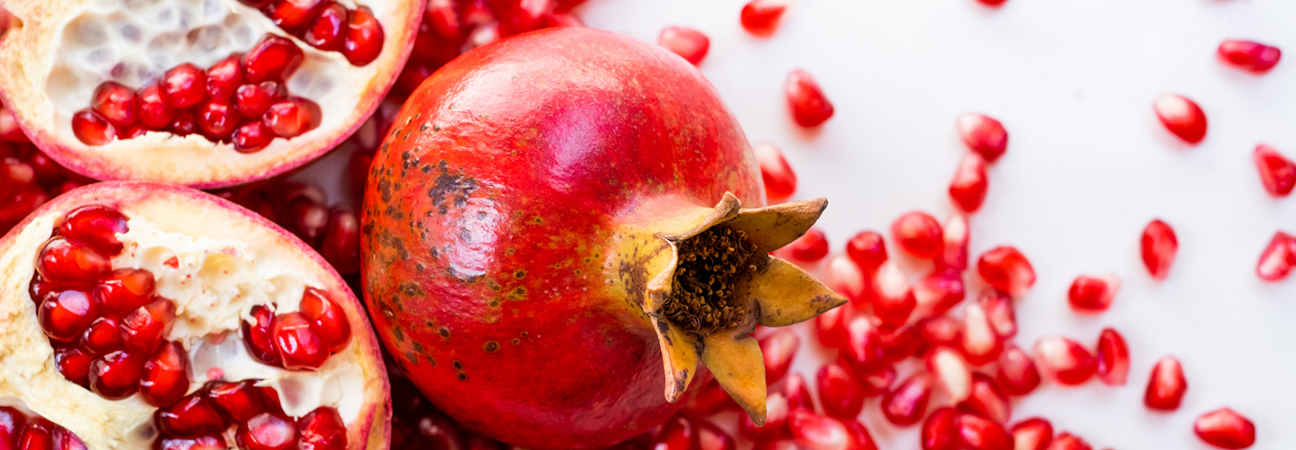Everything you need to know about pomegranates – and the best way to peel them!

If you’re a fan of Middle Eastern food, you will have enjoyed these bursts of sweet and sour flavour in many traditional dishes. Here’s what you need to know about pomegranates, and how to extract those jewel-like seeds out without making a huge mess!
It’s Autumn and we are well into pomegranate season in Australia. This beautiful fruit originates from the Middle East however commercial production of pomegranates, which started in Australia in the early 2000s, is now a thriving industry. While pomegranate trees will grow in Tasmania and are very ornamental, it’s sadly a little too cold for their fruit to mature here. Pomegranates need an extended, dry summer and the Northern Mallee, about 200 kms north-east of Adelaide, is where most of Australia’s commercial pomegranate crop is grown.
The demand for pomegranates in Australia has increased due to emigration into Australia of Middle Eastern cultures, who have brought their delicious cuisine with them, and the rise of celebrity chefs such as Nigella Lawson and Yotam Ottolenghi, who have brought Middle Eastern cooking into the kitchens of home cooks.
An ancient fruit
Pomegranates have long been valued and appear in Greek myths, the Bible and the Quran. Hades lured Persephone into returning to the underworld for a few months every year so that she could partake of this delectable fruit. Pomegranates are also associated with fertility, and therefore with Aphrodite, the goddess of Love, and Hera, the goddess of marriage and childbirth. In ancient Rome newlywed women wore crowns of pomegranate leaves and the juice was said to cure infertility. In the Bible it is said that the original apple which tempted Eve was in fact, a pomegranate. In the Quran, pomegranates are referenced often and grow in the Garden of Paradise.
Beautiful, and good for you!
Pomegranates are high in polyphenols, vitamin C and folic acid. These compounds have been found to be protective against serious diseases such as heart disease, diabetes and cancer. You would have to eat quite a few pomegranates to gain these benefits, so drinking pomegranate juice is a great way to enjoy this healthful fruit.
How to use pomegranates
Pomegranates are best used fresh, the seeds, known as arils, providing a wonderful burst of tartness and flavour to all sorts of dishes. They can be scattered over salads, used as a garnish over roasted meat and vegetables, in a rice pilaf, or in desserts.
Pomegranate molasses can be used in salad dressings, drizzled over meats and vegetables before cooking or used as a marinade. It can even be used as a cordial, diluted with sparkling water, or even champagne!
Pomegranates marry well with lamb, eggplant, tomatoes, pumpkin, oranges, mint, yoghurt, haloumi, feta, cauliflower and labneh.
Here are some ideas for using pomegranates from our recipe collection:
Dukkah Crusted Lamb Chops with Mint and Pomegranate Salad
Citrus Salad
Stuffed Butternut Pumpkin
Pomegranate and Haloumi Salad
Curried Cauliflower Salad
Sumac Labneh
Fruit and Nut Cake
Pomegranate Fizz
And the best way to take the seeds out of a pomegranate?
There are a few methods – who could forget Nigella Lawson banging half a pomegranate with a wooden spoon? This may be fun but makes an almighty mess! The method we prefer is the one used by Middle Eastern people since antiquity – taking off the top and then making six strategic shallow cuts lengthwise through the skin following the white pith lines. The fruit then opens to reveal its jewel-box interior – and to allow easy removal of the seeds.
Watch this video to learn how.

